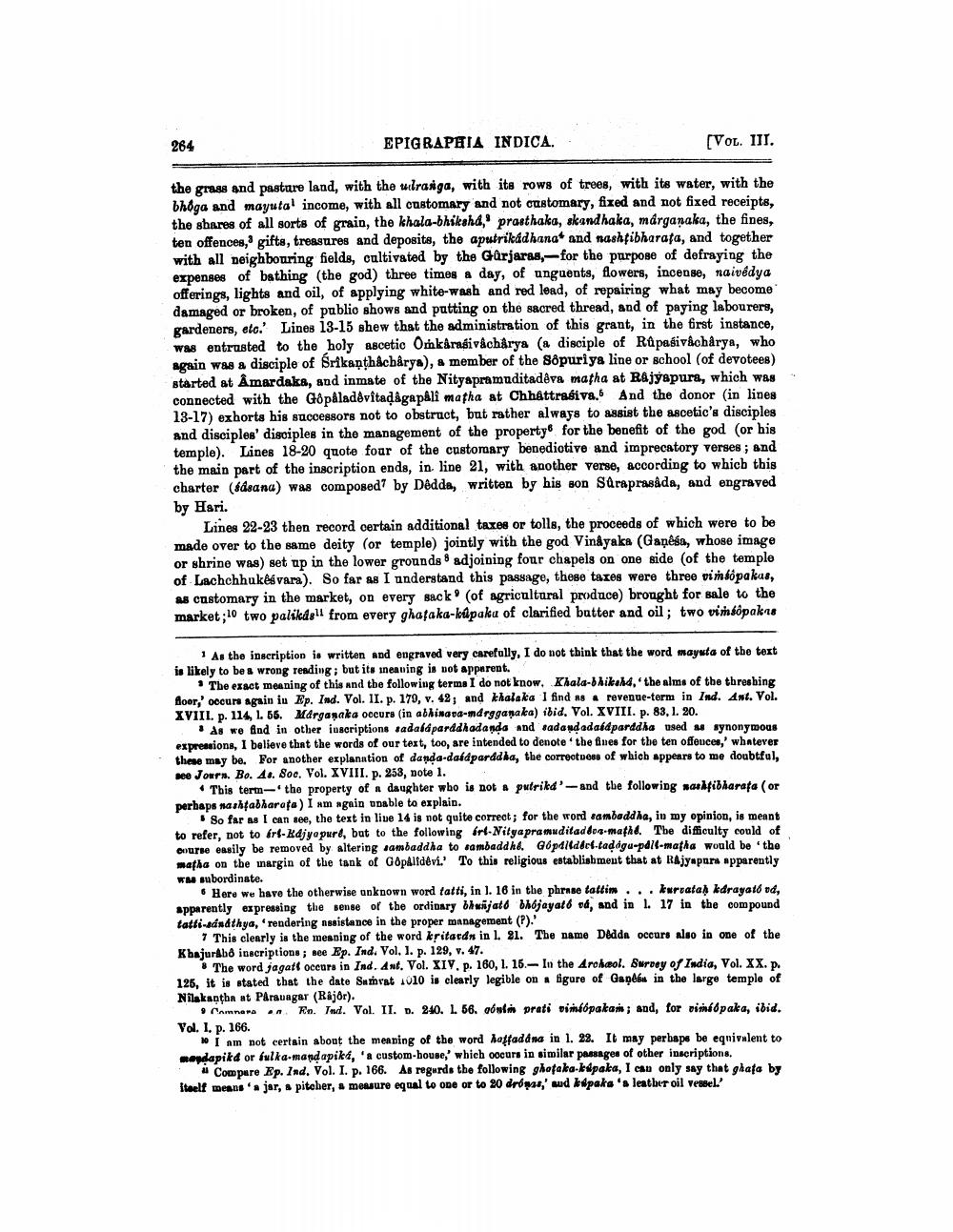________________
264
EPIGRAPHIA INDICA.
VOL. III.
the grass and pastare land, with the ulranga, with its rows of trees, with its water, with the bhoga and mayutal income, with all customary and not customary, fized and not fixed receipts, the shares of all sorts of grain, the khala-bhikshd, prasthaka, skandhaka, márganaka, the fines, ten offences, gifts, treasures and deposits, the aputrikádhanat and nashtibharata, and together with all neighbouring fields, cultivated by the Gârjaras,- for the purpose of defraying the expenses of bathing (the god) three times a day, of unguents, flowers, incense, naivedya offerings, lights and oil, of applying white-wash and red lead, of repairing what may become damaged or broken, of public shows and putting on the sacred thread, and of paying labourers, gardeners, etc. Lines 13-15 shew that the administration of this grant, in the first instance, was entrusted to the holy ascetic Omkarašivacharya (a disciple of Rûpasivacharya, who again was a disciple of Srikanthacharya), a member of the Sôpuriya line or school (of devotees) started at Åmardaka, and inmate of the Nityspramuditadêya matha at Rajyapura, which was connected with the Gôpåladdvitadagapali matha at Chhattrašiva. And the donor (in lines 13-17) exhorts his successors not to obstruct, but rather always to assist the ascetic's disciples and disciples' disciples in the management of the property for the benefit of the god (or his temple). Lines 18-20 quote four of the customary benedictive and imprecatory verses ; and the main part of the inscription ends, in line 21, with another verse, according to which this charter (fasana) was composed by Dedda, written by his son Suraprasada, and engraved by Hari.
Lines 22-23 then record certain additional taxes or tolls, the proceeds of which were to be made over to the same deity (or temple) jointly with the god Vinayaka (Ganesa, whose image or shrine was) set up in the lower grounds & adjoining four chapels on one side (of the temple of Lachchhukesvara). So far as I understand this passage, these taxes were three virkópakus, as customary in the market, on every sack' (of agricultural produce) brought for sale to the market; two palikdall from every ghafaka-kúpaku of clarified butter and oil; two vimfôpakas
1 As the inscription is written and engraved very carefully, I do not think that the word mayuta of the text is likely to be wrong reading, but its ineaning is not apparent.
• The exact meaning of this and the following terms I do not know. Khala-bhikand, the alms of the threshing Aoor,' occurs again iu Ep. Ind. Vol. II. p. 179, v. 42; and khalaka 1 find as a revenue-term in Ind. Ant. Vol. XVIII. p. 114, L. 66. Margaşaka occurs (in abhinava-mdrggaraka) ibid. Vol. XVIII. p. 83. 1. 20.
as we find in other inscriptions sadald parddhadanda and sada dadaidparddha used a synonymous expressions, I believe that the words of our text, too, are intended to denote 'the fue for the ten offouces,' whatever there may be. For another explanation of danda-daláparddha, the corrector of which appears to me doubtful, Nee Journ. Bo. 4.. Soc. Vol. XVIII. p. 253, note 1.
• This term the property of a daughter who is not a putrikd'-and the following manfibharata (or perbaps nashtabharafa) I am again unable to explain.
So far as I can see, the text in live 14 is not quite correct; for the word rambaddha, in my opinion, is meant to refer, not to brf-Kdjyogurt, but to the following int-Nitgapramuditaddon-mafhd. The difficulty could of Dvure easily be removed by altering sambaddha to sambaddad. Gópilledef-laddgu-pdlf-matha would be the matha on the margin of the tank of Gopalfdevi.' To this religious establishment that at Rajyapars apparently WM subordinate.
Here we have the otherwise unknown word tatti, in l. 16 in the phrase tallin ... kurvata) kdragató ud, apparently expressing the sense of the ordinary bhaijat bhojayat 6 ed, and in 1 17 in the compound tatti-sandthya, 'rendering assistance in the proper management (R).
7 This clearly in the meaning of the word kritardns in l. 91. The name Dedda occurs also in one of the Khajurabð inscriptions ; see Ep. Ind. Vol. 1. p. 129, v. 47.
* The word jagatt occurs in Ind. ant. Vol. XIV. p. 160, 1. 16. - In the Archeol. Survey of India, Vol. XX.p. 126, it is stated that the date Sumrat 4010 is clearly legible on a figure of Gapéu in the large temple of Nilakantha at Paravagar (Rajør).
. Camera. Ro. Tod. Vol. II. D. 240. L. 56. aós prati bimbópakan; and, for nimipaka, ibid. Vol. I. p. 166.
10 I am not certain about the meaning of the word Raffaddna in 1. 22. It may perhaps be eqnivalent to mapdapild or fulka mandapika, 'a custom-house,' which occurs in similar passages of other inscriptions
Compare Ep. Ind. Vol. I. p. 166. As regurds the following ghotaka-ldpaka, I can only say that ghata by Iteelf meansjar, piteber, a mensure equal to one or to 20 drops,' sud kipaka's leather oil vessel




